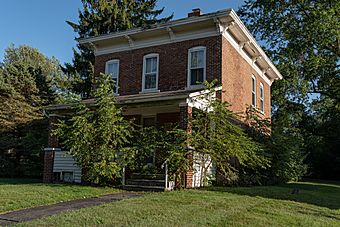Wilson Bruce Evans House facts for kids
|
Wilson Bruce Evans House
|
|
 |
|
| Location | 33 E. Vine St., Oberlin, Ohio |
|---|---|
| Area | less than one acre |
| Built | 1856 |
| Architectural style | Italianate |
| NRHP reference No. | 80003143 |
Quick facts for kids Significant dates |
|
| Added to NRHP | April 16, 1980 |
| Designated NHL | December 9, 1997 |
The Wilson Bruce Evans House is a special historic house located at 33 East Vine Street in Oberlin, Ohio. It was finished in 1856 and became a very important stop on the Underground Railroad. This secret network helped enslaved people find freedom.
The brothers who built the house, Wilson Bruce Evans and Henry Evans, were also part of a famous event in 1858. This event was called the Oberlin–Wellington Rescue, where they helped rescue a person who had escaped slavery. Because of its important history, the house was named a National Historic Landmark in 1997.
What the House Looks Like
The Wilson Bruce Evans House is just south of downtown Oberlin. You can find it on the south side of East Vine Street, across from Martin Luther King Jr. Park. This park is a small public space behind the Oberlin City Hall.
The house is a two-story building made of brick. It has a special roof style called a hip roof. The roof has edges that stick out, decorated with cool brackets. A porch with a simple roof covers the front of the house. This porch roof is held up by square brick pillars.
Inside, the house has beautiful wooden details. Wilson Bruce Evans and Henry Evans, who were free African-American brothers, made and shaped all this woodwork themselves. They built the house between 1854 and 1856. Wilson Bruce Evans and his family lived there. Even in 1997, when it became a landmark, the house was still owned by their family members.
A House Full of History
The Evans house was the home of Wilson Bruce Evans, a very important African-American abolitionist. Abolitionists were people who worked to end slavery. Wilson Bruce Evans also helped Oberlin College, which was the first college to accept students of color.
Evans became well-known after his role in the 1858 Oberlin–Wellington Rescue. This event was one of many that challenged a very unfair law called the Fugitive Slave Act of 1850. This law made it harder for enslaved people to escape to freedom.
Even though Evans was not as famous as other abolitionists like Sojourner Truth or Frederick Douglass, people said he was a man who "put justice above his own safety." This means he cared more about what was right than about his own danger. The house was a frequent and safe stop for many travelers on the Underground Railroad, including brave people like Harriet Tubman.



